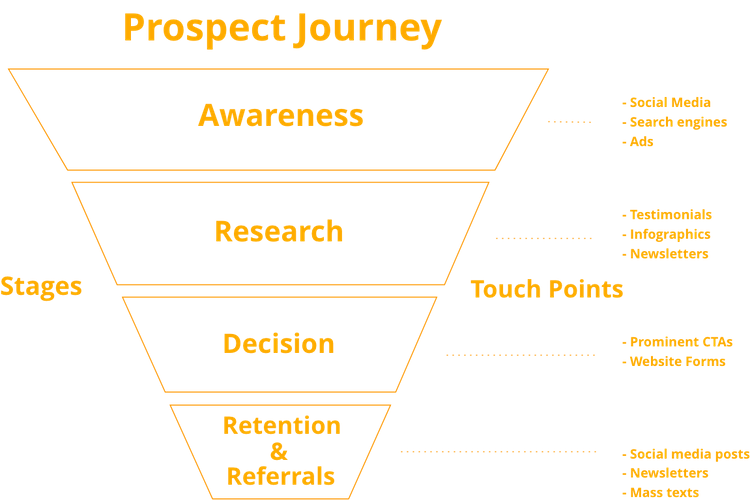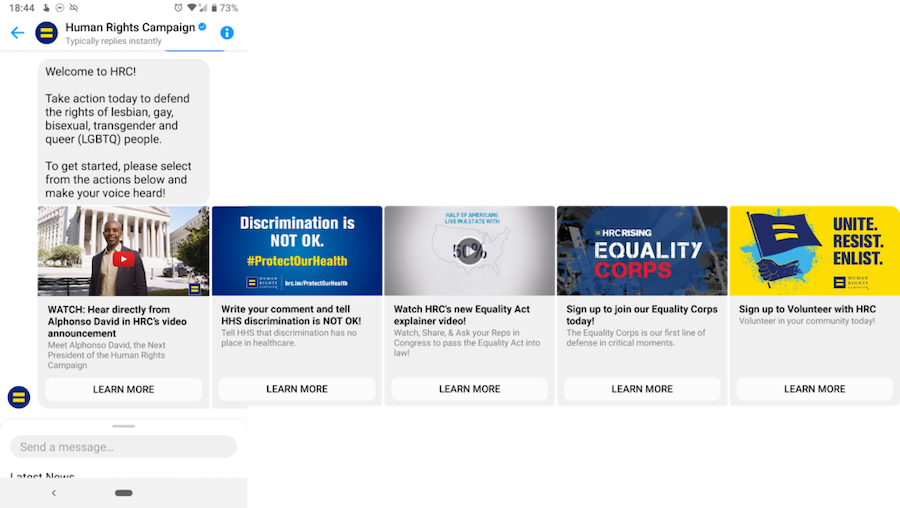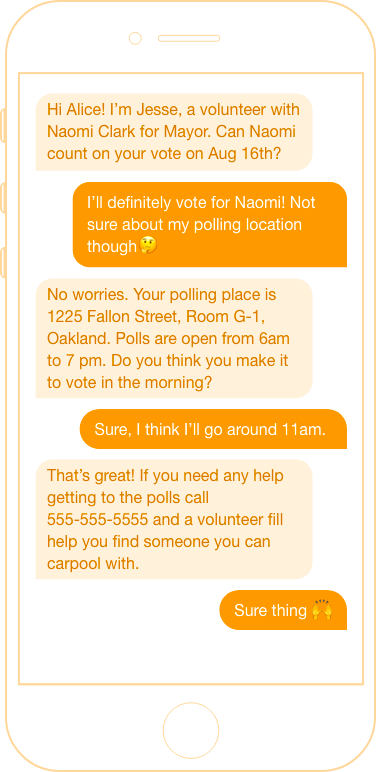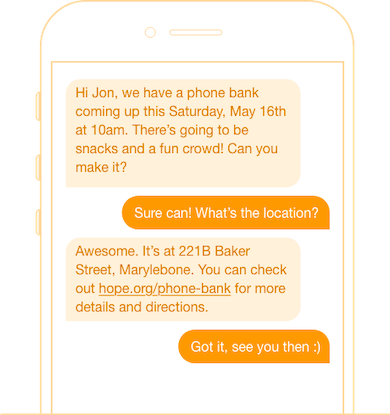Table of Contents
In our introduction to conversational marketing, we talked about how conversations were the best way to engage prospects, build genuine relationships, and move them along the path to taking action.
But how can you fit it into your marketing strategy?
Well, the idea is to help you build a relationship with your prospects (via conversations), and leverage relationship marketing to boost conversions.
To start with, let’s understand how relationship marketing and conversational marketing work together.
Relationship marketing is the practice of building processes that focus on long-term, personal engagement with supporters and customers, as opposed to short-term benefits (which is typical of transactional marketing.)
Conversational marketing is a subset of relationship marketing, which focuses on using engaging conversations through various channels to build relationships and convince prospects to take action.
In order to find out how conversations, and more broadly, relationship marketing can work with how you currently interact with prospects, you need to map out your prospect journey.
What does the average prospect journey look like?
A prospect journey is a combination of all the interactions your organization has with prospects across various touchpoints, and how it encourages them to act.
The journey can change depending upon the channel used, the prospect’s intention and also how you interact with them.
These interaction channels could be across:
- Your website
- Newsletters
- Social media posts
- Direct mail
- Events
- Mass Texts
Here’s a generic prospect journey that you could broadly apply to yours:

How and where you communicate with prospects largely determines the success of your outreach efforts. Which is precisely why mapping out your prospect journey is so important. This map can help you:
- Find gaps in your prospect journey
- Identify opportunities to better engage your prospects (i.e. use conversational marketing or combine it with transactional marketing)
- Provide consistent messaging across touchpoints
Where do most common touchpoints fall short?
Despite having a detailed customer journey, many organizations find that their conversion (and retention) funnel is not working as well as expected.
The trouble here is not the journey. It is also probably not when they communicate. It is how they communicate.
A lot of the ways businesses and nonprofits communicate with prospects across these touchpoints are highly transactional or unengaging.
That is, a lot of ‘communication’ along these touchpoints are updates about bill payments, or simply newsletter communication.
These messages do not typically encourage a response.
That might work in the short term, getting people to sign up for your newsletter or make a one-time donation.
But for building long term, meaningful relationships between you and your prospects? Try relationship marketing.
How to adopt relationship marketing
Focusing on relationship marketing does not mean replacing traditional transactional marketing techniques.
In a lot of situations, it simply involves augmenting the existing systems you have in place. In others, it’s just changing how you use an existing communication channel.
Finding new areas of the donor/customer journey to implement relationship marketing is all about recognizing the weak points in your organization’s prospect journey.
Start by evaluating your existing systems of communication across your prospect journey.
- Are you bringing enough traffic to your website?
- Are enough of those people converting?
- Are you engaging them to bring them back in the future?
These questions will tell you how well your current strategy is performing. Any weak spots simply mean an opportunity in the donor/customer journey for you to implement relationship marketing.
While implementing a relationship marketing approach might initially increase your spending, the returns will be worth it!
Continued engagement of prospects with conversational, relationship marketing strategies will improve your ROI.
Applying relationship marketing across your prospect journey
You may be reaching out to prospects in a variety of ways. Some of them could be working pretty well. Others, not so much.
And yet other channels could potentially convert better if done through relationship marketing and conversational messaging.
In our post introducing conversational marketing, we talked about those channels that lend themselves to relationship marketing:
- Text messages
- Chatbots
- Phone Calls
We will now look at how a combination of these channels and a few others can be used in implementing a relationship marketing strategy.
Let’s go through the common touchpoints organizations have at each stage of the process, and examples of how to use relationship marketing to make them better:
Raising awareness
For most organizations, this is the first step in the prospect journey. They aim to make a prospect more aware on two counts:
- On the cause/problem they are looking to tackle
- On the fact that their organization is the best solution to tackle the problem
How is it usually done?
An easy way organizations reach people is through social media or social media ads. Posting to followers is free, and there’s always a chance that they will share it with their circle of friends and family.
And finally, there’s good old Search Engine Marketing. Here, organizations optimize their pages for search engines or buying search ads.
Doing it better – Influencer Marketing
Above, we talked about organizations asking social media followers to share their posts. Take it a notch further by reaching out to influencers in the space you’re targeting.
More effective than seeing an ad, or reading a blog post, the opinions and views of influencers hold immense sway over their followers.
Getting an influencer to endorse your service or promote your cause can plug you directly into the consciousness of thousands of people, in a way that you couldn’t achieve on your own.
Take the example of the Yogscast, who host a series of live streams over the course of the month of December, raising money for multiple partnered charities.

Forming and maintaining relationships with influencers is going to take significant time and effort on your end. But the end result? Quality leads that are much more likely to convert.
Facilitating research
Once prospects are pulled in by the first contact, they are in research mode. They want to know more – about the problem and also about the organization.
In this stage, organizations make it easy for prospects to find the information.
How is it usually done?
With high-quality content, they:
- Show prospects everything they need to know about the organization.
- Convince them why they’re better than their competition.
In this context, the content involves success stories, testimonials, videos, infographics, and newsletters to help prospects better understand the organization.
Doing it better – Chatbots for conversations
You want to make it as easy as possible for prospects who land on your social media or website to learn what they need. Maybe even give them a gentle nudge in the right direction.
While there are ways to do it, you naturally won’t be able to reach out to every person that lands on your site personally. That’s where chatbots come in.
You can set up bots to engage people who reach your website or your Facebook page with relevant questions and answers.

Do they want to learn more about your organization? Have the bot share a link to the page.
They want to know the products on offer? Let the bot send a quick summary.
They want to try out your service? Let them book a demo.
They want to sign up for your newsletter? Have the chatbot collect their opt-in.
Not only are you able to give prospects the information they need, you are also able to gather data on them for further communication.
Enabling a decision
Once they’ve done their research, prospects decide whether to invest in a business or a nonprofit.
The final decision is made by them, yes, but organizations do help it along with targeted high-quality content, and powerful CTAs.
How is it usually done?
For instance, they make the donation button as prominent as possible. They also provide multiple donation options to facilitate easier conversions.
They also ensure that the conversion journey is as seamless as possible to avoid drop-offs. That means, the CTA across all channels takes them directly to the final landing page.
For instance, if it is a donation page, it is mobile friendly, has an easy to fill form and a quick way to donate.
Doing it better – Making an ask through a conversation
Take for example, if your organization is soliciting donations through social media posts to followers.
Social media is a pretty great tool. It makes it easy to reach a ton of people at once. But it’s hard to have engaging, personal conversations with supporters.
Conversations are more likely to convince someone to take action, be it to attend an event or donate to a cause.
So you can use other channels that help you have a back and forth:
- Emails are slightly more personal. You can populate data fields with a prospects name, for instance. They are worth having as part of your marketing toolset. But having one-on-one conversations at scale is still hard.
- Phone calls are tried and tested for businesses. But nonprofits with limited volunteers probably won’t have the bandwidth to make calls to all their supporters.
- Chatbots are great if prospects have already made the decision to give and just want to be directed to your donation page. The disadvantage here is that they don’t get to talk to a real person.
So, how do you have targeted, personal, scalable conversations that convince people to take action? Enter, peer-to-peer texting.
Agents and volunteers can reach out to prospects to have highly personalized conversations, leading them along the path of taking action.
Take this example of a GOTV campaign using peer-to-peer texts:

By having a volunteer available to answer questions, and guide voters to the polls, you are much more likely to succeed in increasing voter turnout.
Doing it better – Collecting data for future engagement
Too many details to fill in an online form are a turn off for most. Change up how you collect your prospect data. We mentioned chatbots above as one way to collect data. However, there are definitely more options out there.
- Collect data after an SMS opt-in
You can set up automated responses to collect data from the people who text into your shortcode.
By making these follow-ups conversational, you increase the chances of getting the information you need from prospects.
The advocacy group, 350.org, used CallHub’s SMS opt-in feature to collect the data points they needed from their supporters to get them to their climate change rallies.
2. Use progressive profiling
This essentially means staggering your data collection so you only collect the most relevant information from your contacts. Further data collection can happen in later touchpoints when it makes the most sense.
For prospects making a first-time donation, it makes sense to ask them for their name and their email address. How about asking them about their giving habits? You might want to save that question for the next time they visit your site.
Or, since you already have their basic details, you could reach out separately to get more information:
- Send surveys through email follow-ups
- Have a form pop up on your product or website
Retaining prospects and getting referrals
Retaining existing supporters and customers, and using those relationships to bring in new people is a big part of the prospect journey.
How is it usually done?
Organizations often take the approach of sending email newsletters, or automated text messages to subscribers to keep them engaged.
They might ask followers to spread the word by sharing social media posts.
Doing it better – Keep prospects engaged through conversations
Once prospects have made an initial donation or payment, or attended an event or rally, keep them engaged with conversational marketing. We talked about how peer-to-peer texting was a channel that made having engaging, personalized conversations easy. Here’s how it can be used to keep prospects engaged:
- Recognize supporters, donors, and volunteers
Appreciation from a real person can go a long way towards building lasting relationships with prospects. Use peer-to-peer texting to thank event attendees, donors, and volunteers.
2. Show them their impact
People want to be validated. Show them that their time and money are well spent by having volunteers send text message updates on how your prospects impacted your mission by taking action.
3. Drive them towards another ask
The point of keeping prospects engaged and taking the effort to build long term relationships is to keep them involved with your organization.

That way, when you have a follow-up ask, the prospects have a higher chance of converting.
Conversational channels like text messages or phone calls are the best ways to pose such follow-up asks.
350.org effectively used peer-to-peer texting in 2019 for such follow-up asks. Supporters who turned up to their rallies were encouraged to sign up via opt-in campaigns.
Later, their volunteers reached out to these supporters via engaging P2P texts and encouraged them to attend further events.
Using relationship marketing with existing tools
Conversational messaging takes a bit more time than your average “set it and forget it” automation. That means you probably don’t want to replace all of your existing flows and automations with it.
Simply introducing conversational messaging via the various channels you are already engaging your prospects can greatly improve ROI. Here are a few ways you can explore:
Augment your emails with text messages
Take for example a thank you email to an event attendee. You could send them a follow-up text asking them for feedback on the event. Not only does it keep them engaged after an event, but it also initiates interactions across multiple channels.
Since that is more to get people to take action, the chances of your prospect responding are higher.
Make your calling outreach more effective
For the prospects who don’t answer your calls, send a follow-up text, letting them know why you called. They’ll be much more likely to pick up the next time around.
For the prospects who do pick up, send them a relevant follow-up text during or after a call.
Calling to ask for a donation? Send them a link to your donation page.
Getting voters to the polls? Send the address to their polling location.
Applying relationship marketing isn’t hard.
In fact, it’s already being adopted by organizations around the world.
Look out for our next post, where we talk about how groups like 350.org have put conversations to engage supporters into practice.

